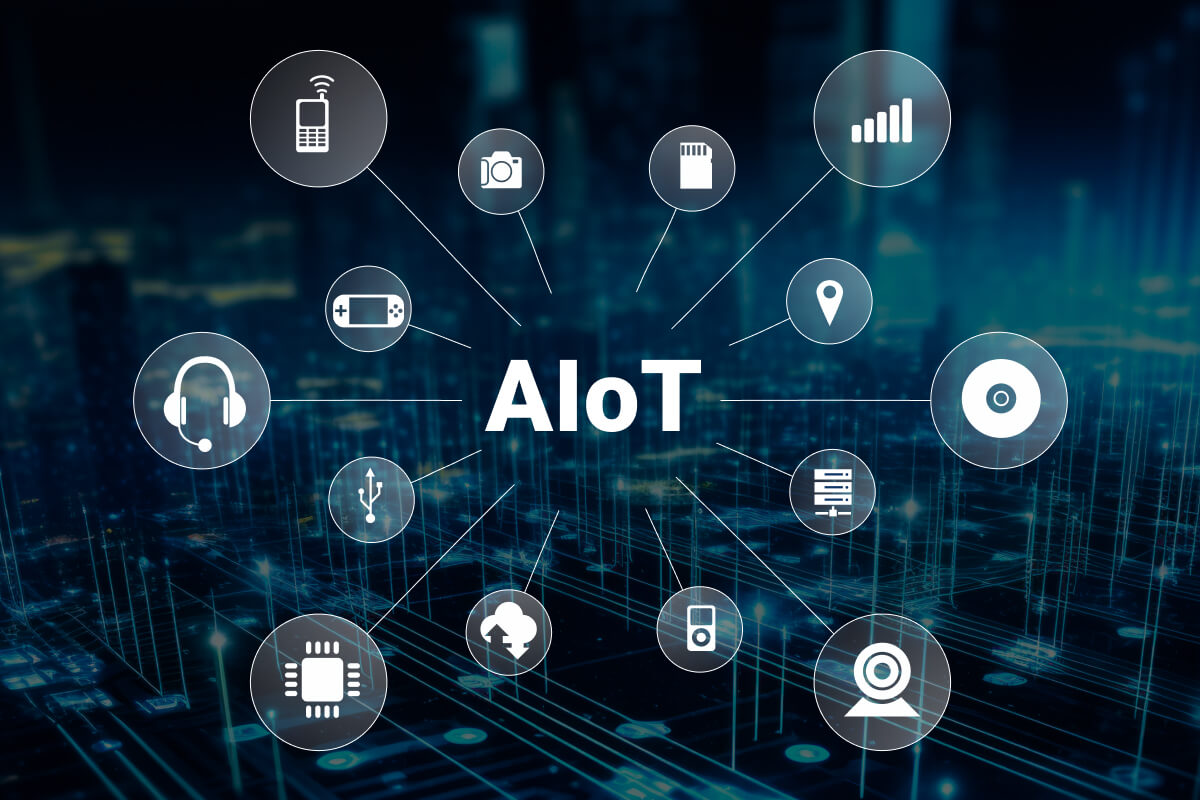Water resource contamination is getting worse as a result of the rapid industrial and urban advancement. Water quality monitoring has emerged as a key means to safeguard the health of both human beings and water resources. By monitoring water quality in time, we may detect water pollution problems at early stage and take necessary measures to prevent further deterioration of water quality.
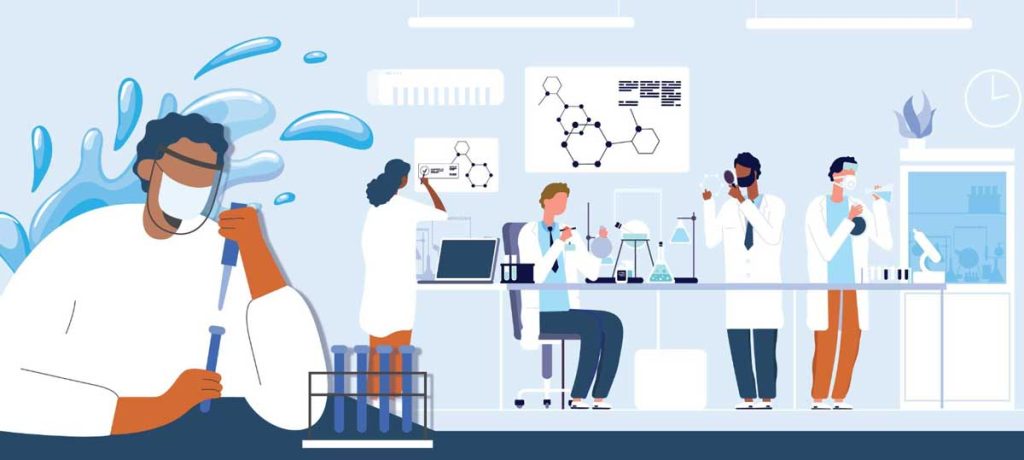
Among many water quality monitoring solutions, the application of Internet of Things technology has garnered a lot of interest. It can strengthen the preservation and management of water resources by enhancing not only the accuracy and real-time monitoring performance but also by lowering the cost of IoT remote monitoring solutions.
Read further: IoT remote monitoring
Importance of Water Quality Monitoring
Water is the most essential resource on our planet, and this is a fact that even every child knows it. But as human activities such as sewage discharge, industrial discharge, agricultural run-off, and urban run-off increase, the polluted watering threatens the quality of drinking water. As a result, people are growing more and more concerned about the safety of the water.
What Cause Water Pollution?
Due to the abundance of pollution sources, there are numerous ways that water pollution might start. City sewage and the discharge of industrial waste are two of the main causes of pollution. The second reason is the presence of pollutants in the water that enter through groundwater systems, soils, or the atmosphere via rain.
The major pollutants of water include viruses, bacteria, fertilizers, parasites, pharmaceutical products, pesticides, nitrates, fecal waste, phosphates radioactive substances and plastics. These substances will not alter the color of the water, but they might be indiscernible contaminants.
Consequences of Poor Water Quality
Human’s over-exploitation of natural resources leads to deteriorating water quality, which is detrimental to the health, environment and economy in different corners of the globe. The consequences of water pollution or poor water quality are as follows (included but not limited to):
- Biodiversity Destruction: water pollution initiates unrestrained increase in phytoplankton in water resources, upsetting the equilibrium of aquatic ecosystems and causing biodiversity loss;
- Food chain contamination: Using polluted water for agriculture and livestock husbandry as well as fishing in contaminated water sources can add toxins or other contaminants to food that are harmful to the body when consumed;
- Drinkable water shortage: Farmers’ usage of pesticides and fertilizers might wash through the soil and end up in waterways. Additionally, industrial waste materials wash into lakes and rivers. As a result, water contamination rises and drinking water quality may not be preserved, leaving less clean water available for consumption, sanitization, or public health;
- Disease: poor water quality may cause various diseases to humans and animals, which in turn affects the life cycle of the ecosystem.
The need for safer water is urgent, and traditional manual water quality measurement may pose a number of challenge, particularly in light of the unpredictable rate of freshwater source depletion and ineffective techniques for assessing water quality in real-time.
Reference:
https://www.sciencedirect.com/science/article/pii/S2666285X2100090X
https://www.mdpi.com/1424-8220/23/2/960
https://smartwaterjournal.springeropen.com/articles/10.1186/s40713-017-0005-y
https://www.ncbi.nlm.nih.gov/pmc/articles/PMC9864729/
Types Of Water Quality Monitoring Parameters
SWQM smart water quality management is the process of measuring critical water quality parameters, identify deviations, provide early warning identification of hazards, and ensure these parameters are within a suitable range. Several important parameters monitored by WQMS systems include:
Salt Levels
Salinity usually builds up in water, especially groundwater. High salinity affects the PH value of water, thereby making it unfit for use by humans or livestock. Due to the fact that salinity increase can cause animal or plant mortality, it’s crucial to monitor these values both in the aquaculture and livestock industry.
Bacteria Levels
A truly unwanted entity in public water is bacteria. The effects of these microorganisms on public health cannot be over-emphasized. Consuming bacteria-infested water can cause various illnesses, from dysentery to diarrhea. WQMS use specific methods to measure pathogen concentrations in untreated or treated water.
Oxygen Levels
Ideally, water should have sufficient dissolved oxygen. Oxygen, the gas which fills up the empty spaces between water molecules, is important for aquatic life. However, some water bodies have more dissolved oxygen than others. This variation exists naturally but is often times influenced by human activity. WQMS can detect when oxygen levels drop below the standard or when other chemicals/elements like nitrogen enter into water.
Why Use IoT Water Monitoring System
The public’s interest in the quality of drinking water has grown since the late 20th century. Water quality monitoring systems to gather real-time information regarding source water quality have been developed by many water utilities. For detecting water pH, turbidity, dissolved oxygen, and other characteristics, a range of smart sensors and IoT remote monitoring systems have been introduced in the early 21st century. Some remote sensing technologies have also been utilized for the purpose of observing ambient water quality in riverine, estuarine, and coastal water bodies,
Reference: https://en.wikipedia.org/wiki/Water_quality
Drawbacks of Traditional Water Management System
Water quality refers to the chemical, physical, and biological characteristics of water based on the standards of its usage. And the water quality is usually sampled and analyzed at laboratories. Such water quality measurement comes with issues like extensive time consumption, cost-intensiveness, and errors and mistakes by human beings.
- Inevitable errors: Despite the workforce receiving sufficient training and education, errors are unavoidable since this is a part of human nature. Mistakes like inaccurate or flawed water quality readings are prone to be made because this is the nature of human beings.
- Time inefficiency: Manual Inspection of probes and sensors waste a lot of time that could have been utilized for generating useful insights from data to draw valuable conclusions and creating more effective plans.
- Cost-intensiveness: The implementation of relevant field research, expeditions, and the transportation of the numerous sensors required for physical and chemical measurements entail unquestionably high costs.
Benefits of Using IoT for Water Quality Monitoring
IoT-based water quality monitoring systems require sophisticated IoT gateway devices, smart sensors, and complicated IoT communication technologies. These IoT devices allow for the measurement and transmission of various parameter data, such as temperature, oxygen content, and pH, to a distant cloud server, allowing for the continuous real-time monitoring of water quality and the gathering of knowledge necessary to make well-informed decisions regarding water management.
Read further: IoT water management
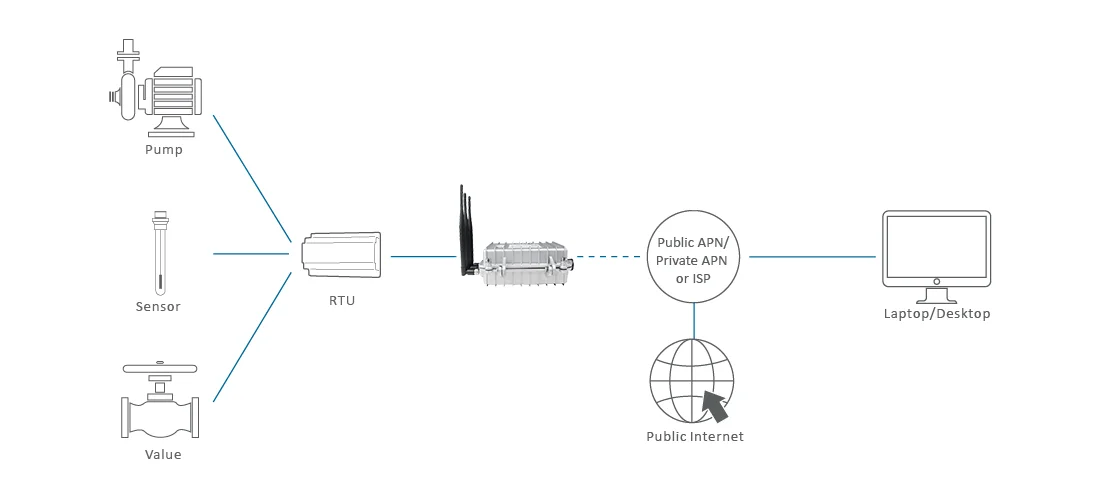
For instance, temperature sensors could be used to monitor the health of a lake or river. Once there is abnormal temperature changes, it is possible to identify potential issues such as algal blooms or changes in the ecosystem. The benefits of water quality monitoring system based on IoT technology can be concluded as follows:
- Real-time water monitoring: the data about the quality of the water at predetermined or desired locations can be sent via outdoor LoRaWAN gateways at periodic intervals to describe current conditions of water;
- Early detection of water pollution: The perilous quality metrics like physical, chemical and microbial properties can be continuously measured and water pollution can be detected in early stage, so as to take appropriate measures and avoid serious situations.
- Timely Alert on condition changes: A network of smart sensors can be sensors deployed across a region of interest and have them all communicate with each other to provide a complete picture of what is happening in that area. Any deviations in monitored metrics can be detected and prompt warning can issued to assist in identifying threats or hazards.
- Cost reduction and efficiency improvement: The use of wireless sensor networks and outdoor industrial gateways in IoT-based WQMS (water quality management system) minimizes the costs of field research. Water measurement can be made mostly in the lab and less on site. Therefore, researches will have more time for data analysis and forecast trends, keeping them one step ahead.
- Eliminate human errors: Because data generated is automatically uploaded, there is no room for oversight or human error.
- Enhanced safety: IoT security is the main challenge of deploying smart water quality monitoring system. Some may concern that the data collected by the sensors is accessed by unauthorized individuals. This safety issue can be fixed by hardware encryption on IoT gateways. Meanwhile, various IoT protocol alliances are also making attempts to strength the security of their systems by incorporating data encryption. Therefore, it can be assumed that IoT networks are fairly secure.
Real-time monitoring of the water’s quality is necessary to ensure the supply of pure water. As smart sensors, protocol conversion gateways, and IoT protocols and technologies advance, smart solutions for monitoring water pollution are becoming more and more important. IoT-based water quality monitoring makes sure the water is up to standard regardless of whether it will be used for drinking, swimming, industrial manufacturing, etc.
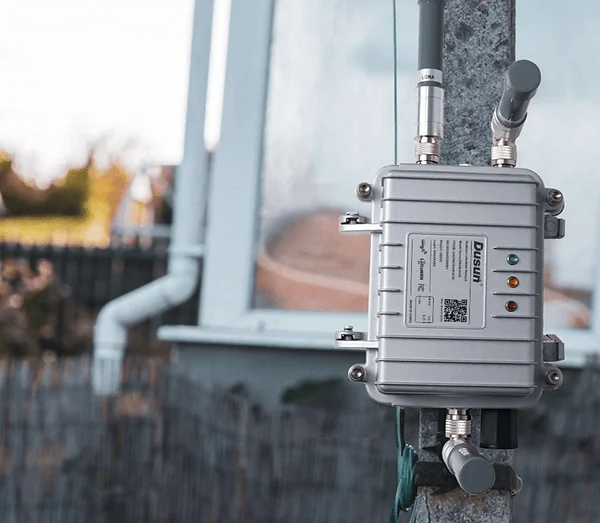
Water PH levels and other crucial characteristics can be monitored in real-time by IoT-based WQMS thanks to the usage of wireless sensor networks. Such information can be sent to the cloud or edge computing gateway, where it will be cross-checked against the acceptable water standard. When any water parameter deviates from the permissible standard, instant action can be done thanks to the real-time monitoring capabilities of WQMS.
How Does IoT Water Monitoring Work and Components Needed
The working principle of IoT-based water pollution monitoring system is not very complicated. It consists of a number of low-powered smart sensors interfaced with the MCU to sense quality parameters, and several IoT gateways with SDKs from ThingsBoard to direct acquired data to the cloud for remote monitoring, as well as a desktop application to perform data classification and analysis. Users can also scale it up by adding different sensors to measure other parameters.
General Building Blocks of IoT Water Quality Monitoring System
Here we are going to use a block diagram to help you understand its working principle better:
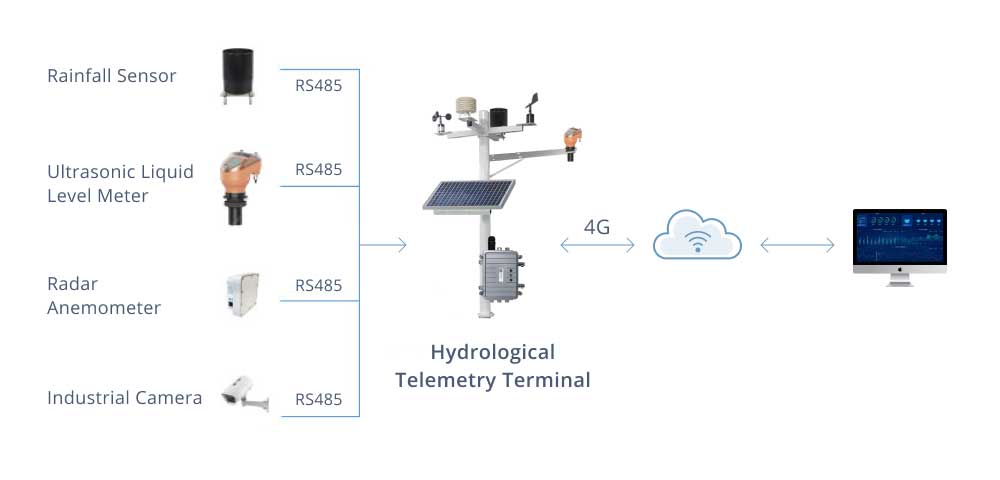
In order to gather information from numerous parameters, the smart sensors are first submerged in the water. Sensors change the physical parameter into an electrical amount that can be measured. The data from sensors is read by an IoT gateway controller, which then uses the appropriate communication technology to convey the data to the application and, if necessary, process it. This allows for remote monitoring as well as remote access if researchers wants to see real-time data using their smartphones or PCs.
Which communication technology to choose and the parameters to be monitored depends on the need of the application. Application includes the data management functions, data analysis and alert system based on the monitored parameters.
Components of IoT Water Monitoring System
After knowing its working principle, it is necessary to know the components of a typical IoT-enabled water quality monitoring system.
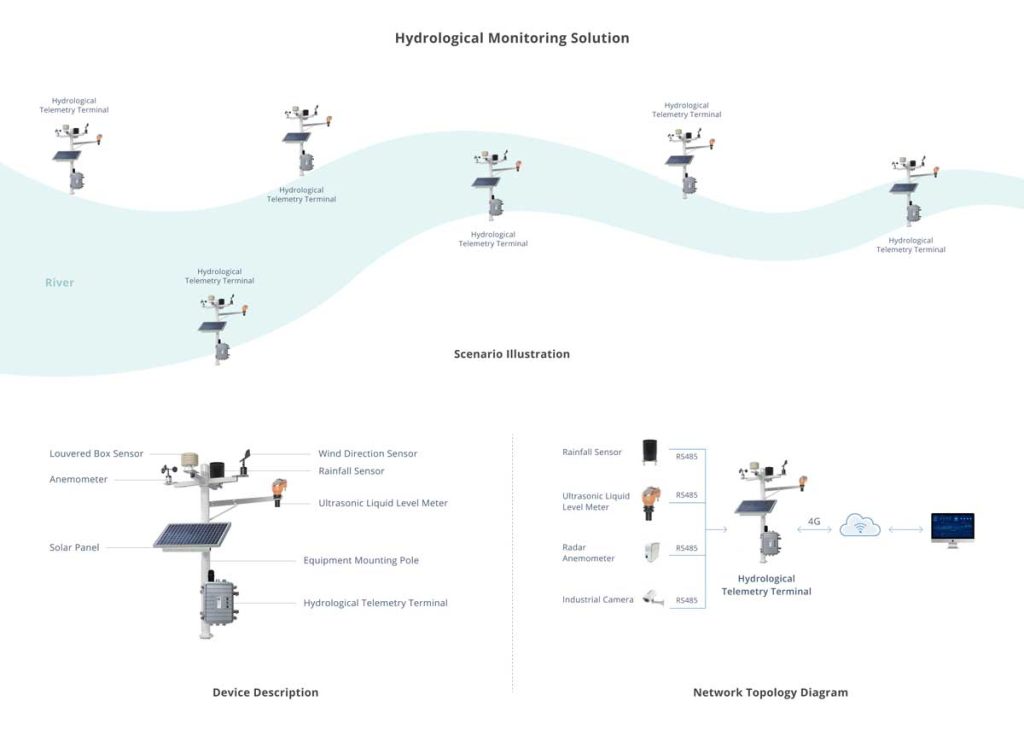
Sensors
Sensors are the core hardware components of IoT-based water quality monitoring systems. They are often deployed in the monitored water sources (such as lakes, rivers, etc.) and are used to measure the above mentioned parameters. A typical WQMS system might include sensors for temperature, pH, turbidity, electrical conductivity, etc.
Meters
To track water usage in homes and businesses, water management solutions also use smart water devices like flow meters. IoT smart meters can assist water utilities in better managing their systems and responding to possible issues by delivering real-time data on water usage.
Gateways
Gateways are the key links between sensor network and cloud servers, especially when these sensors are not able to use IP address. The data from the water quality monitoring system cannot be uploaded to the cloud without an IoT gateway acting as a bridge to the Internet. Low-power wide area networks (LPWAN) or other wireless communication protocols like WiFi, Bluetooth, or Zigbee may be used to connect sensors in smart water quality monitoring systems.
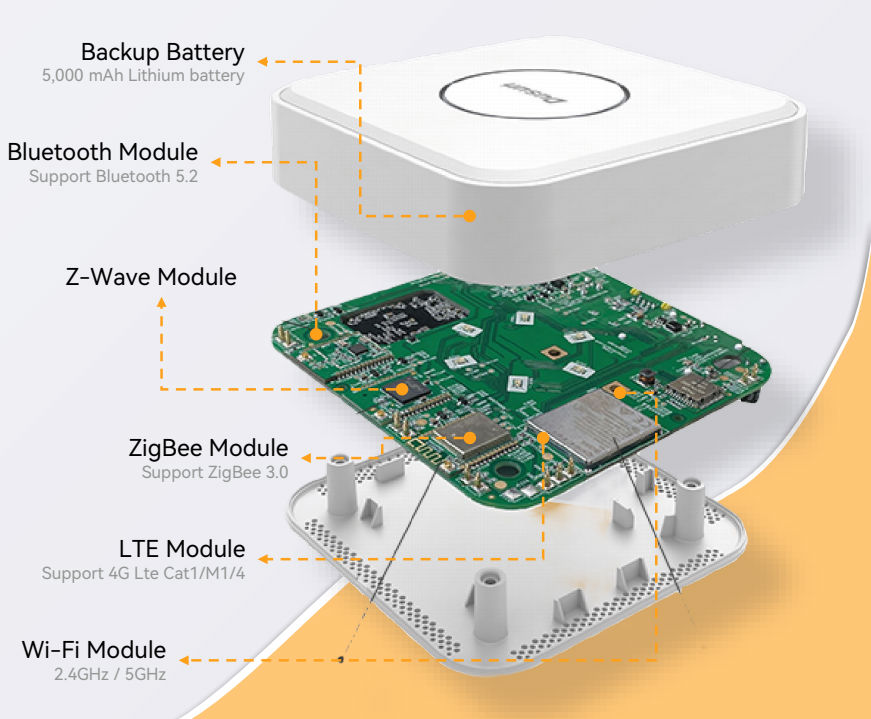
Edge Computing Devices
The capacity of the gateway used would depend on the scale of the water project or system. Edge computing gateway might be an excellent option to store data locally, process it within the gateway, and make immediate alert in accordance with your predefined rules if you want to lower the cost of cloud services and decrease latency.
Cloud Server
The central server or cloud service can store and process the sensor data by uing software or algorithms to find trends and patterns. An alarm will be issued to the necessary authorities to take action if there is a concern with the water quality.
Other Custom IoT Hardware
It is possible to develop hardware that is specifically designed for water quality monitoring. When the required features or capabilities are unavailable in commercial products, developing custom hardware may be the only viable choice. However, it can be more expensive than utilizing off-the-shelf hardware in some circumstances. For instance, if a business wants to develop IoT gateways with particular performance characteristics or has to integrate the hardware into a bigger system with particular specifications, it may design custom hardware.
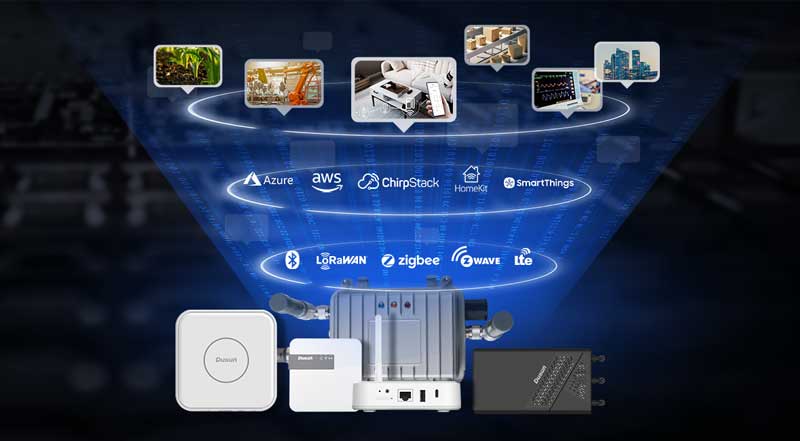
Application Scenarios of Water Quality Monitoring Using IoT
IoT is going tol to revolutionize many industries and change the way we live our lives. IoT in water quality monitoring is already starting to make a difference in many cases. A water quality monitoring application involves using different IoT smart sensors that keep track of the parameters in real-time. Also, the monitoring system provides real time analysis of data collected and suggest suitable remedial measures.
The Internet of Things will revolutionize many industries and alter how we live. IoT is already beginning to change several situations in water quality monitoring. Utilizing several smart sensors that track the parameters in real-time is part of a water quality monitoring application. The monitoring system also offers real-time analysis of the data gathered and recommends appropriate corrective actions.
Monitor Various Pollutants in Water Sources
WQMS are used to monitor the water quality of local waterways in towns and cities of various countries to ensure adequate oxygen levels for aquatic life and protect the freshwater ecosystem of those regions. The pH, temperature, dissolved oxygen, and the presence of chemicals and microbes are just a few of the factors that smart sensors can measure in rivers, lakes, and other bodies of water. This information can be sent in real-time to a central monitoring system, where it can be examined and used to spot possible problems and, if necessary, take corrective action.
Certain parts of the US are already incorporating this technology, for instance, Green Bay. The shallow water at Green Bay makes it susceptible to oxygen deficiency. Also, decaying algae at the water bottom depletes oxygen much faster, creating dead zones that have oxygen levels low enough to kill fish. The WQMS employed here helps prevent/detect such dead zones and also helps forecast future conditions of the region’s freshwater.
Water Quality Management in Residential Settings
Water Quality Monitoring Systems also provides indoor water monitoring for tenants in residential buildings. Smart water meters can be installed in homes and places of business to track water usage, find leaks, and give early notice of potential problems like the presence of lead or other toxins in the water supply. These gadgets can assist water utilities in better managing their systems and responding swiftly to possible issues by providing real-time data on water usage and quality.
Final Words
In conclusion, water quality monitoring is a crucial tool for safeguarding both human health and water resources. By using the Internet of Things technology, we can realize real-time monitoring and early warning, gain a better understanding of the water quality status, and and quickly take action to stop water pollution and deterioration. IoT water quality monitoring can not only improve the accuracy and efficiency of smart water management, but also significantly enhance the conservation of water resources.
In the future, we have reason to assume IoT technology will play a more important role in the field of water quality monitoring and can be widely used employed in various sectors like water utility supplying pure water, optimum water quality for agricultural high yield of crop production, and wastewater treatment, etc.













